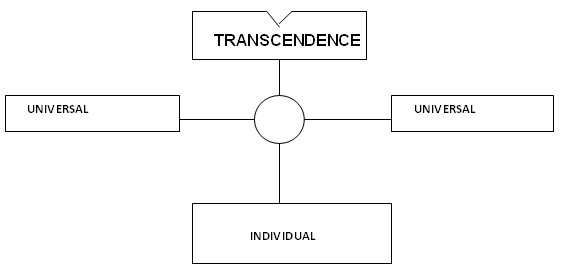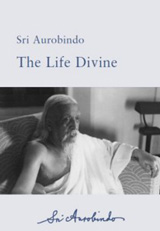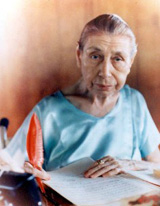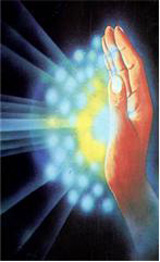Integral Health
The metaphysical basis for Integral Health – the three poises of reality
The concept of health and the discipline of healing evolved to serve life. It is life per se that is the raison d’être of existence. That is why health and healing are the noblest of all disciplines pursued by the human being. And that is also why health and healing cannot be isolated subjects, mechanically pursued by an objective mindset. The concept of health is not only linked with our physical, emotional, social and cognitive development, it is also linked with the higher-order pursuits of existentialism, metaphysics and philosophy and our deeper pursuits of true religious experience and spirituality. The basic tenets of health therefore can be linked at multiple points of the spectrum of consciousness in the quest for Truth. It would be interesting in this context to understand the significance of health in consonance with the experiential concept of Reality as perceived in the spiritual heritage of India.
In Chapter III of The Life Divine, Sri Aurobindo describes how Reality is simultaneously manifested in the Individual, Universal and Transcendent poises. In the Individual poise, Consciousness is concentrated within the limits of Space and Time so that a particular creative drama can be enacted. In the Universal poise, Consciousness is diffused beyond the constraints of Space and Time so as to complement the Individual poise. The Transcendental poise surpasses both the Individual and the Universal, permits them, exhausts them and is yet independent of them.
The Universal poise of Reality can be experientially perceived when one exceeds the ego-sense and enters the Cosmic Consciousness where universal thoughts, universal rhythms of art and music, archetypal images and universal movements of love and oneness intermingle to form a vast gestalt. The individual exists only in relation with others and is not a ‘centre’ of the universe but a centre within the universe through which universal forces and archetypal ideas act to produce effects that have universal ramifications.
However, the Cosmic Consciousness by itself is not the perfect poise of Consciousness as it holds the contradictory movements of Truth and Falsehood, giant forces that can rule or ruin, gigantic waves of stabilisation and destabilisation. Beyond the Cosmic Con-sciousness is the Transcendent —”transcendent not only of the ego, but of the Cosmos itself, — against which the universe seems to stand out like a petty picture against an immeasurable background. That supports the universal activity, — or perhaps only tolerates it; It embraces Life with its vastness, — or else rejects it from Its infinitude (1).”
The Transcendent is symbolised by a perfect oneness that potentially holds the duality of both the unity and the multiplicity, the Infinite and the Finite, Timelessness and Time. That the Transcendent is simultaneously one and two at the same time was always known in spiritual traditions. The Mother explains that this was the original significance of the Cross in Christianity (2). In fact the Mother, who gave names to flowers in tune with their hidden psychological attributes, chose the cork-oak of India (Milling Tonia hortensis) to symbolise ‘Transformation’. This flower has four petals. The petal at the top represents the ‘Transcendent’; the two on either side represent the ‘Universal’ and the one at the bottom represents the ‘Individual’. These four petals are arranged like a cross and as the Transcendent is one and two at the same time, the petal at the top is bifurcated. The Mother points out that as a symbol, this petal-arrangement is more perfect than the Cross (3).
It is important to note that the Transcendent, the Universal and the Individual are different poises of the consciousness that co-exist at the same time. “There is constantly a transcendent, constantly a universal, constantly an individual, and the tran-scendent, universal and individual are co-existent. That is, if you enter into a certain state of consciousness, you can at any moment be in contact with the transcendent Shakti, and you can also, with another movement, be in contact with the universal Shakti, and be in contact with the individual Shakti, and all this simultaneously — that does not unfold itself in time, it is we who move in time as we speak, otherwise we cannot express ourselves (4).”
The ‘Transcendence’ is called God in many religious disciplines. The ‘Transcendent’ is quite often considered to be the only Reality with the Universal and the Individual subservient to it. In Indian tradition, the supreme Consciousness is equally represented in the Transcendental, Universal and Individual poises. Yet an experience of the Transcendent can suddenly give an experience of the ‘unreality’ of the world. It is an overpowering experience that influences ascetism to reject life. But Sri Aurobindo prefers a wider, integral synthesis where the Transcendent, the Universal and the Individual have their proper representations. He expresses the triune status of the Reality poetically:

“My vast transcendence holds the cosmic whirl;
I am hid in it as in the sea a pearl (5).”
Significance in Integral Health
It is interesting that the significance of health exists simultaneously at the three poises of Reality. Actually, an integral perspective of healthy living should ideally take into cognisance this triune nature of Reality. In the spiritual psychology, the ordinary human being, who is a confused amalgam of habits, desires and reflexes held together by scattered ideas and associations, does not merit the status of an ‘individual’ unless one has organised the various parts and planes of the being around a Beyond-ego, soul-principle. If the individual shifts the focus from one’s egocentricity to the soul-principle (the Psychic Being), one can bear suffering with calm and equipoise. After all, the Sanskrit word for health, svaasthya, indicates a state of being rooted in one’s spiritual essence or ‘self’. This deeper soul-poised consciousness is free from psychological disturbances, subconscient influences and egocentric biases and is also immune from attacks by adverse forces. The soul-based poise allows us to be spontaneously happy, joyous, peaceful and integrated, independent of outer conditions and adversities.
Surpassing the ego, one comes into contact with the cosmic consciousness, enabling one to be receptive to the universal healing forces and facilitating rejuvenation by the boundless energy in the universe. Through intensive spiritual practice, yogis in India came into contact with deeper energy-levels (the Pranic Śakti) behind the surface personality which is in dynamic communion with the Universal Śakti. The Universal Śakti in the cosmic consciousness and the Pranic Śakti in the depths of the individual are two ends of the spectrum of the unitary consciousness and, if linked, can activate dynamic healing processes. Sri Aurobindo explains about this Śakti, “We can become aware of the existence and presence of the universal Shakti in the various forms of her power…. which supports and fills the body and supplies all the physical and vital activities, — for the physical energy is only a modified form of this force, — and supplies and sustains too from below all our mental action. This force we feel in ourselves also, but we can feel it too around us and above, one with the same energy in us, and can draw it in and down to aggrandise our normal action or call upon and get it to pour into us. It is an illimitable ocean of Shakti and will pour as much of itself as we can hold into our being (6).”
And the Transcendent is not only God to whom we offer prayers for recovery and invoke the Grace for life. The Transcendent permits the individual and the cosmic to complement each other, to interpenetrate each other and to exist for each other. The Transcendent is not beyond our individual grasp or our cosmic flow but inherently implicit in the matrix of the being as an essence, as the fulcrum of Truth around which existence gets a meaning, life gains a harmony, the diverse planes of consciousness achieve integration and health moves along a trajectory of perfection needed to support the quest for fulfilment and salvation.
References
1. Sri Aurobindo. SABCL, Volume 18. Pondicherry; Sri Aurobindo Ashram Trust, 1970, p. 17.
2. The Mother. Collected Works of the Mother, Volume.4. Pondicherry; Sri Aurobindo Ashram Trust, 1972, p. 393.
3. Ibid. 4. Ibid., p. 394
5. Sri Aurobindo. SABCL, Volume 5. Pondicherry; Sri Aurobindo Ashram Trust 1971, p.131.
6. Sri Aurobindo. SABCL, Volume 21. Pondicherry; Sri Aurobindo Ashram, Trust, 1970, p. 727.
Share with us (Comments, contributions, opinions)
When reproducing this feature, please credit NAMAH, and give the byline. Please send us cuttings.



